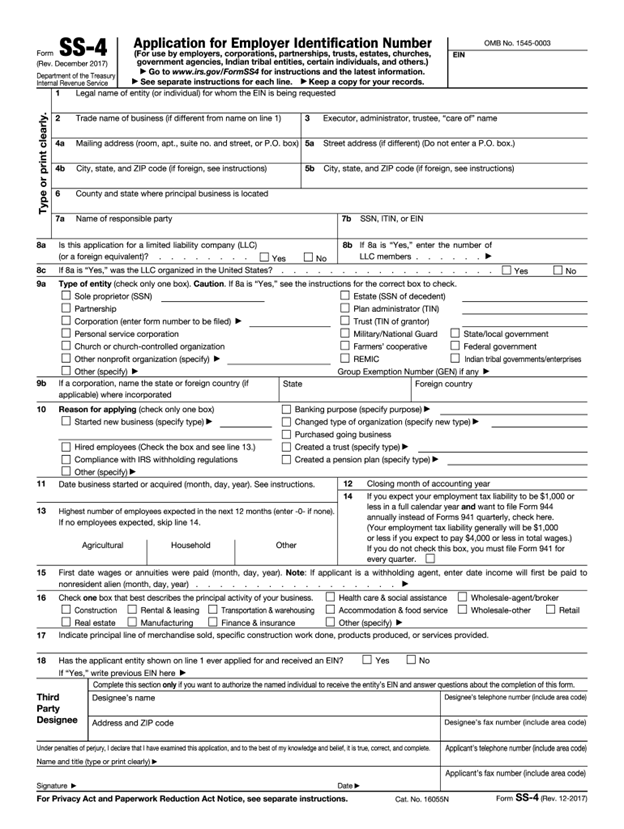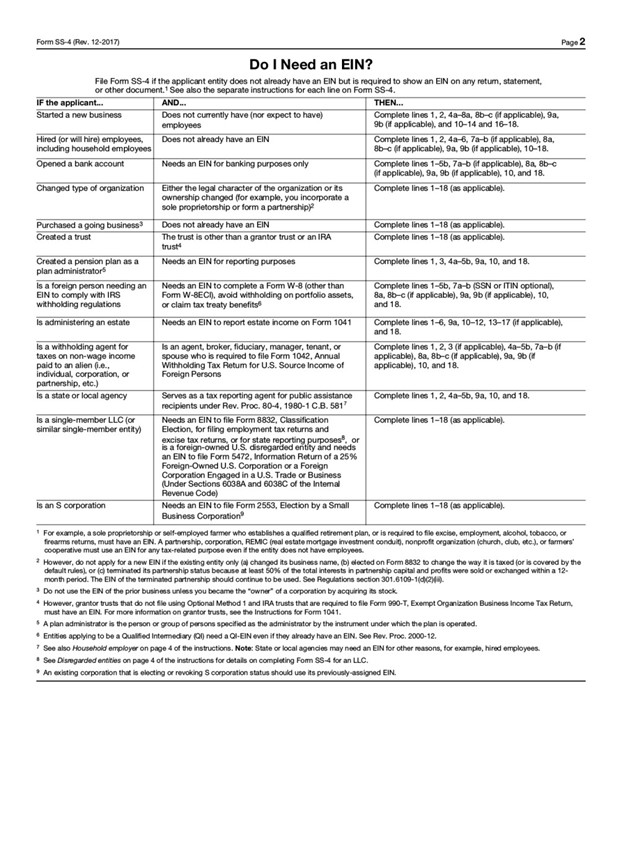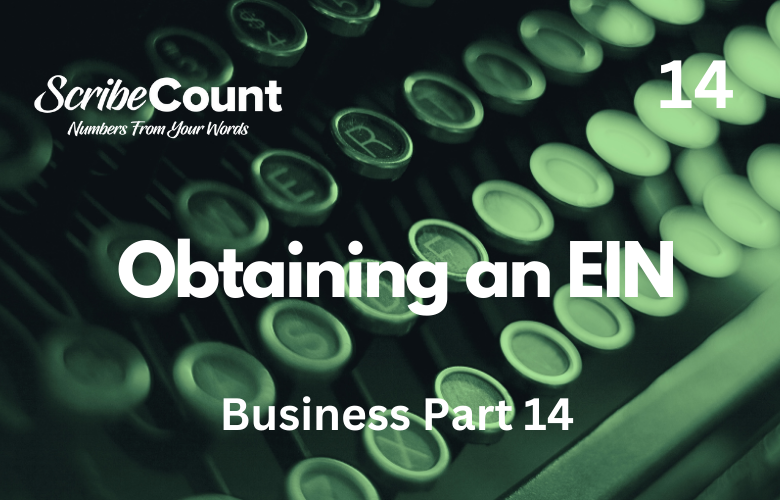Obtaining your EIN
What is an EIN?
EIN stands for Employee Identification Number. Unfortunately, this title does a poor job of explaining what it is and what it does. An EIN is also known by several other names:
Employer ID Number
Employer Identification Number
Federal Employer ID Number
Federal Employer Identification Number
FEIN
Federal Tax Number
Federal Tax ID Number
Federal Tax Identification Number
Regardless of what your state labels it (Federal Tax Identification Number is the most accurate), all of these titles refer to the same thing.
So what exactly is it?
The simplest explanation: An EIN is the number that the Internal Revenue Service (IRS) computer uses to identify your business. Whenever your LLC interacts with a government agency, be it Federal, State, or Local, it will use your EIN.
Remember, your LLC is a separate entity, but not a living person. Real people have Social Security numbers, businesses have EIN numbers. It’s important not to mix them up as fixing this issue with the IRS is a difficult task.
It’s easy to spot the difference,
While a Social Security number and an EIN number both have nine digits, they are separated differently by hyphens.
Social Security: 888-88-8888
EIN: 99-9999999
What do you need an EIN for?
An EIN will be needed to open your LLC’s business banking accounts, apply for your local business licenses, handling payroll, obtaining business lines of credit or loans, obtaining credit cards in the name of the LLC, and for filing your tax returns. Having your EIN will allow you to file an electronic tax return, make electronic payments, and get you an IRS Taxpayer Identification Number (more about this later).
Costs:
EIN’s are free.
TIP: Obtaining an EIN is one of the easiest steps in the LLC process. Some websites will try and charge for this service, which amounts to one form and about fifteen minutes of your time, so be aware.
How can you obtain your EIN?
NOTE: Your LLC must be approved BEFORE you can apply for an EIN. If you were to file for an EIN first, and your LLC’s paperwork be rejected, you would then have an EIN for a business that doesn’t exist. Always wait until you have a stamped confirmation from the state before applying with the IRS for an EIN number. The IRS cannot process an application online if the party is an entity with an EIN previously obtained through the Internet.
An EIN can be obtained in one of three ways:
- Mail (takes up to four weeks)
- Fax (takes up to four days)
- Online (takes about fifteen minutes)
PhoneWhile the IRS website still lists this as a choice, they no longer service this option.
By choosing the online option your EIN will be issued as soon as you have completed the online application. You’ll receive a confirmation letter and downloadable copy of your EIN. You should immediately save and print your new EIN and confirmation letter and file it away with your other LLC paperwork. It’s also a good idea to jot the EIN number down somewhere you can readily access it as you will be referring to it often as you complete the LLC process.
Note: You will need Adobe Reader installed to receive an online confirmation letter.
Here is IRS form SS-4, which you will need to submit in order to obtain your EIN.


Let’s walk through this form and fill it out.
Line 1: Legal Name of Entity
This is simply your LLC’s name exactly as you have stated it in your Articles of Organization.
Line 2: Trade Name of your business.
This refers to a DBA (Doing Business As) or Fictitious Name. Unless you are using one for your publishing business, you can leave this line blank. We cover DBA's in another article.
Line 3: Executor, Administrator, Trustee, or “Care Of” name.
This can be left blank as it does not apply to LLC’s obtaining an EIN.
Line 4a, b, and c: Mailing Address
This should be the address of your Registered Agent as defined in your Articles of Organization.
Note: The form moves downward at this point and not side-to-side. Be careful to utilize the correct box.
Line 5a and 5b:
If you are using your Registered Agent's address in 4a, b, and c, you can leave these lines blank.
Line 6: County and State where your business is located.
This refers to your Registered Agent's address.
Note that the form says COUNTY and not COUNTRY.
Line 7: Name of Responsible Party
This refers to the LLC member who is filing the form, NOT the Registered Agent.
IRS Definition of Responsible Party:
“The “responsible party” is the person who ultimately owns or controls the entity or who exercises ultimate effective control over the entity. The person identified as the responsible party should have a level of control over, or entitlement to, the funds or assets in the entity that, as a practical matter, enables the person, directly or indirectly, to control, manage, or direct the entity and the disposition of its funds and assets. Unless the applicant is a government entity, the responsible party must be an individual (i.e., a natural person), not an entity.“
In the eyes of the IRS this boils down to one simple thing: who signs the tax return.
While your accountant or lawyer may act as the LLC’s Registered Agent, and even prepare the LLC’s taxes, they are not the one who signs them at the bottom before they are sent off to the IRS. The person who signs is either a designated member of the LLC who has taken on the responsibility for the company’s taxes, or the Manager of the LLC.
NOTE: This form is not public information. It is considered private information kept on file with the IRS. The name and contact information of the Responsible Party is not available in public databases.
Line 7b: SSN, ITIN, or EIN (of the Responsible Party)
This refers to the Social Security Number of the Responsible Party.
TIP: Although the form states it, EIN is no longer an option in line 7b.
Line 8a: Is this application for a Limited Liability Company (LLC)?
Check “YES”.
Line 8b: Enter the number of LLC members:
Enter whatever applies to your particular LLC. Note that this is members only, do not include employees.
If this is a husband and wife LLC, and your LLC is located in a community property state, you should enter “1”. If your LLC is NOT in a community property state, enter “2”.
As of 2025, there are only nine community property states: Arizona, California, Idaho, Louisiana, Nevada, New Mexico, Texas, Washington, and Wisconsin. Research your state's tax laws regarding this before making your decision.
Line 8c: If line 8a was “YES”, was the LLC organized in the United States?
Check “YES”
Line 9a: Type of Entity
***It is strongly recommended that you speak with an accountant or tax attorney before making this decision***
It’s important to understand that LLC’s do not have their own tax designation from the IRS. Every LLC is “taxed as a _____”. That blank can be filled with a number of things; Sole-Proprietor, Partnership, S-corp, and C-corp are among the most popular. Each option has its advantages and disadvantages and these primarily relate to the number of members the LLC has, who those members are, the members marital status in relation to one another, and where the members are located.
The best tax structure for one LLC may not be the best for another.
Based on that decision you will select one of the following here in Line 9a.
- If you are filing as a Single-Member LLC (owned by a U.S. individual) then you will check off the box marked Other (specify) and enter: “Disregarded entity – Sole Proprietorship”.
- If you are filing as a Single-Member LLC (owned by foreigner) then you will check off the box marked Other (specify) and enter: “Foreign-owned U.S. Disregarded Entity”.
- If you are filing as a Multi-Member LLC you may choose to be taxed as a Partnership, S-Corporation, or C-Corporation.
If you chose Partnership then check the box marked “Partnership”.
If you chose S-Corporation then check the box marked “Corporation” and enter “Form #1120S”.
Note: After you receive your EIN you must then file Form 2553 to make your S-Corp election.
If you chose C-Corporation then check the box marked “Corporation” and enter “Form #1120”.
Note: After you receive your EIN you must then file Form 8832 to make your C-Corp election.
Line 9b: State & foreign country (if applicable)
This refers to the state where your LLC was formed. Be sure to use the state’s full name and not an abbreviation.
Line 10: Reason for applying:
Check the box marked “Started a new business (specify type)
Here it gets a little confusing as the IRS hasn’t caught up with modern-day publishing. The IRS uses something called the North American Industry Classification Code. It’s used to identify a business’s line of work and it helps them produce reports on the economy and compare similar businesses when auditing.
Out of the hundreds of codes, these two most-closely match self-publishing.
- Internet Publishing and Broadcasting (NAICS 516)
- Publishing Industries (except Internet) (NAICS 511)
Since you will be publishing in both the e-book and physical book formats, it's recommended that you use both. In order for them to fit on the line provided it's suggested you put “Publishing NAICS 516, 511”
Line 11. Date the business started:
This refers to your LLC’s “Effective Date”, found in the approved Articles of Organization or in the approval stamped on the documents.
Line 12. Closing Month of Calendar Year:
The normal calendar year for filing taxes is January through December. Unless you are deviating from this, enter “December”.
Line 13. Employees:
This can be confusing for the self-publishing author. It’s important to know the difference between a full or part-time employee and an independent contractor. Examples would be an Author Assistant that receives a monthly paycheck and a cover artist that is hired for a single job. There are various tax laws (and forms!) that go with each. It is strongly advised that you speak with your accountant and/or tax attorney regarding this issue.
This paper from the IRS can help you determine who is an
employee and who is an independent contractor.
If you have employees already or plan to hire some in the next twelve months you need to enter them here. These numbers are not set in stone, you won’t be obligated to hire people simply by stating a number that later turns out to be short. This is an approximation only.
NOTE: You, yourself, are NOT an employee of the LLC unless you choose to have your LLC taxed as an S or C corp. If an S-corp you will be required to take a salary as an employee, if a C-corp this salary is optional.
There are three sections listed. Agricultural, Household, and Other. Since the publishing process does not involve growing crops or raising cattle, you can enter “0” under Agriculture. Household includes such categories as maids and babysitters, which your company may hire to clean your office space or watch your children while you work. Again, consult with an accountant before making this decision.
For more information on what the IRS defines as “Household” see this: Household.
Chances are you will use the “Other” section if you have some employees helping you with your business. Again, your accountant can best tell you how to safely navigate this section.
Note: Do not leave the field blank. If you have no employees now, and no plan to hire any in the next twelve months, you should enter “0”, “0”, and “0”.
Line 14. Employment Tax Liability:
If the answer to Line 13 was “0” you can leave this blank.
NOTE: If you plan to have employees you’ll need to withhold and pay taxes to the IRS on behalf of those employees. Again, consult with an accountant to accurately estimate your employment tax liability.
You may also leave this box unchecked if:
- Your employment tax liability will be greater than $1,000
- Your employment tax liability will be less than $1,000, (but you’d rather file Form 941 quarterly)
Line 15. First Date Wages or Annuities were paid:
If you answered “0” in Line 13 you will enter “N/A” (Not Applicable)
If you already have employees and have paid them enter the date of their first paycheck.
If you have employees but have not started paying them yet, enter the date you plan to start. This is an approximation and does not bind you in any way. The IRS will not demand that you abide by this date, nor will it affect your EIN application.
Line 16. Principal Activity:
For the self-publisher this is simply a repeat of Line 10. Select “Other (Specify) and enter “Publishing NAICS 516, 511”. If you wish to add more, “Books” is sufficient.
Line 17. Check one box that principally describes your activity:
This is asking you to better define what it is your publishing company will do. They are asking for your primary product. Since publishing is hard to break down, this section is a bit redundant.
Select “Other (specify)” and enter “Books”.
Line 18. Has the applicant ever applied for an EIN before?
If this LLC has applied for a number before, select “Yes” and enter the previous EIN.
If this is a new LLC than select “No”.
Third Party Designee:
If you are the Responsible Party, and are completing this form for your own LLC, you may leave these four fields blank.
Applicant’s signature, phone, and fax
Name and title: Enter the full name and title of the Responsible Party. If they are an LLC Member (owner), use the title “Member” after their name. For example, “John Smith, Member“.
Signature and date: Sign and enter today’s date.
Applicant’s telephone number: Enter your phone number*.
Applicant’s fax number:
A fax number is needed only if you are submitting IRS form SS-4 by fax. If
submitting by mail you can leave this field blank.
*This should be your dedicated business phone number if you have set one up. If you have not it must be the number for the Responsible Party. See our previous article for information on dedicated business phone numbers.
Page 2.
IRS form SS-4 is two printed pages. However, the second page is nothing more than instructions and not necessary for filing. Page one is all that is required.
Before you file
- Make two copies of your completed SS-4 and file them along with your LLC paperwork.
If you intend to Fax your application you may do so to the following number:
855-641-6935
A cover sheet is not required.
If you intend to mail your application to the IRS you may do so here:
Internal Revenue Service
Attn: EIN Operation
Cincinnati, Ohio 45999
IRS Phone Number & Contact Information
If you have any questions about Form SS-4, you can call the IRS at 1-800-829-4933.
IRS business hours are Monday through Friday between 7am and 7pm local time. (Pacific time if in Alaska or Hawaii) The earlier you call, the shorter the wait times.
Need to Cancel an EIN?
If you made a mistake with your first EIN application, or you need to cancel your EIN Number for any reason, you’ll need to mail a cancellation letter to the IRS.
TIP: EINs are never actually cancelled, they just stop being used. If you cancel an EIN with the IRS its technically called “Closing a Business Account”. You don’t have to wait for your EIN cancellation to be finalized before getting your LLC a new EIN.
1. Create an EIN Cancellation Letter
Sample:
Date: 1 January 2040
ABC Products, LLC
123 Main Street
Capitol City, DA 12345
Internal Revenue Service
Mail Stop 343
Cincinnati, OH 45999-0023
Attn: BMF Entity Department
Request: Cancel EIN / Close Business Account
To Whom it May Concern,
Please close the following business account associated with EIN 88-8888888. This account is no longer being used.
Name/Business: ABC Products, LLC
Fictitious Name: Widgets for Everybody
Mailing Address: 123 Main Street.
Capitol City,
DA 12345
EIN: 88-8888888
I have included a copy of the original EIN Assignment /Confirmation Letter.
Please mail a confirmation letter to the address listed above.
We can be reached at (555) 123-4567 should you have any questions,
Thank you,
John Smith
John Smith, Manager, ABC Products, LLC
jsmith@email.net
TIP: BMF stands for “business master file”
2. Mail the Cancellation Letter to the IRS
NOTE: The Entity Department of the IRS no longer has a fax number. All EIN cancellations must be done by mail.
Internal Revenue Service
Mail Stop 343
Cincinnati, OH 45999-0023
Attn: BMF Entity Department
NOTE: Be sure to include a copy of your original EIN Confirmation Letter.
Confirmation of EIN cancellation:
You should receive a confirmation letter from the IRS within 45 days. If you do
not we advise that you add “Second Request” to the top of the original letter
and send the cancellation letter (with another copy of the original EIN) again.
If you have successfully obtained your EIN, it’s time to think about Banking.

